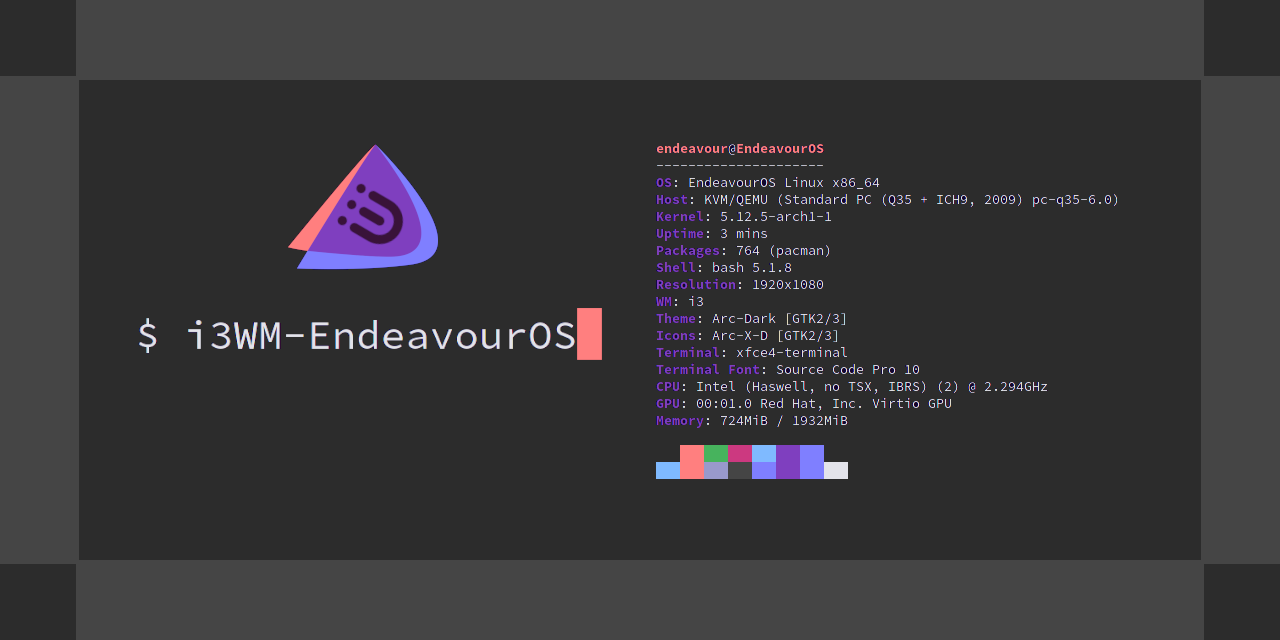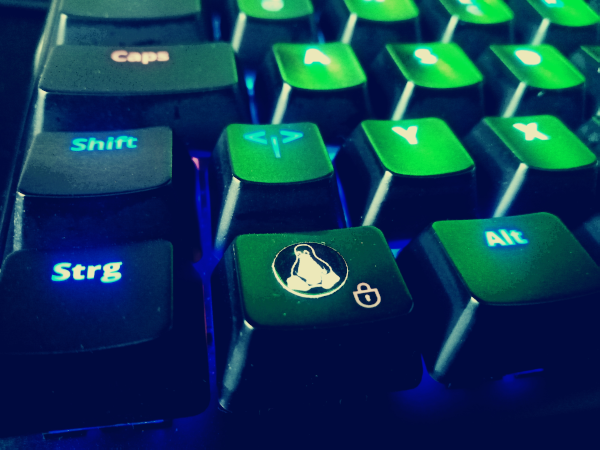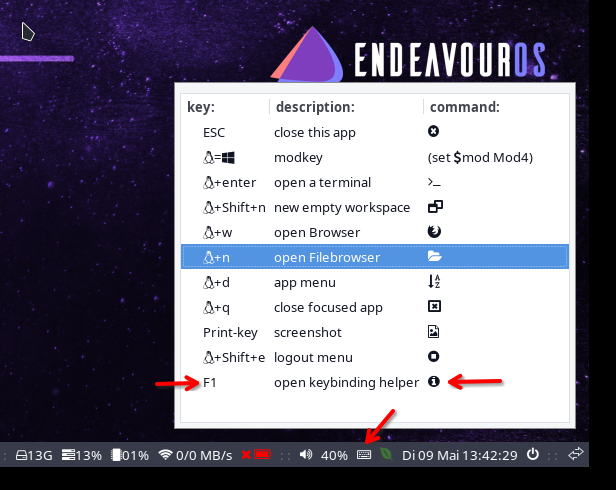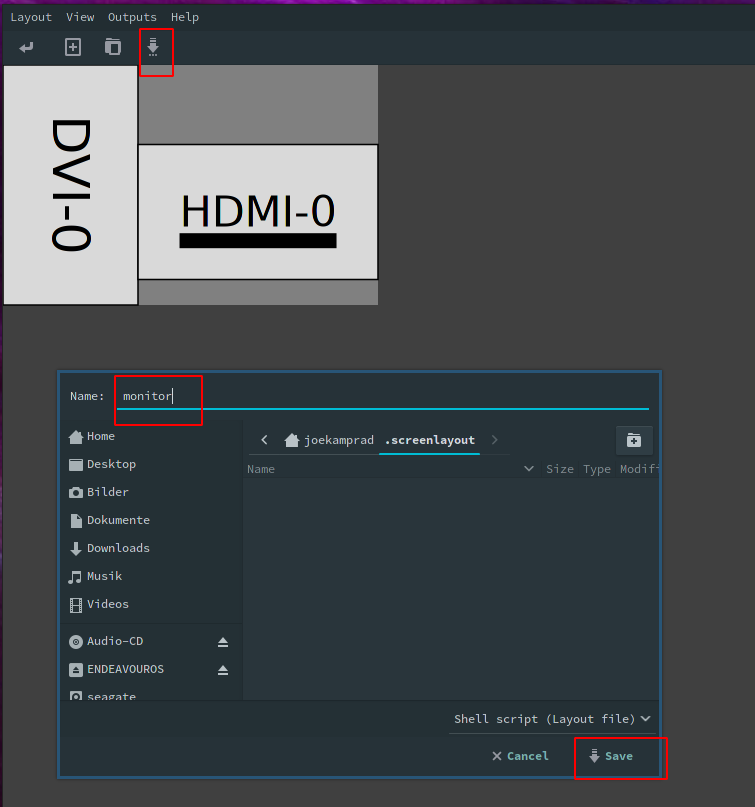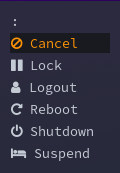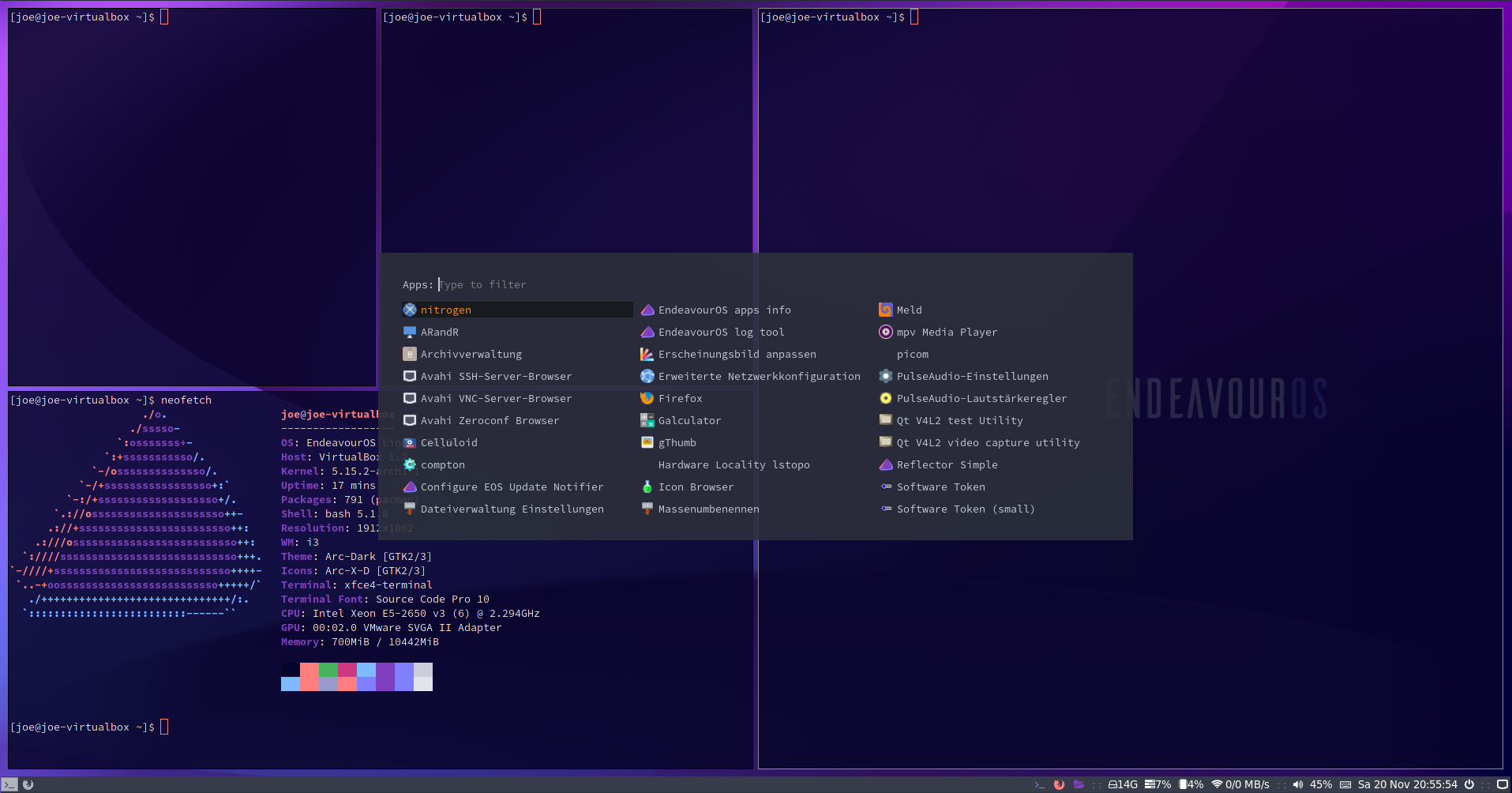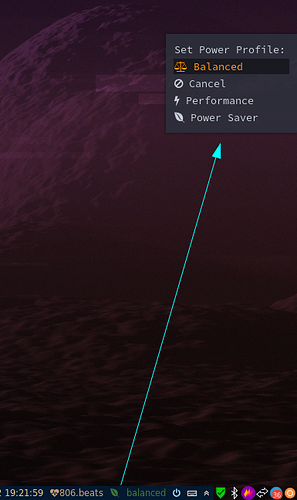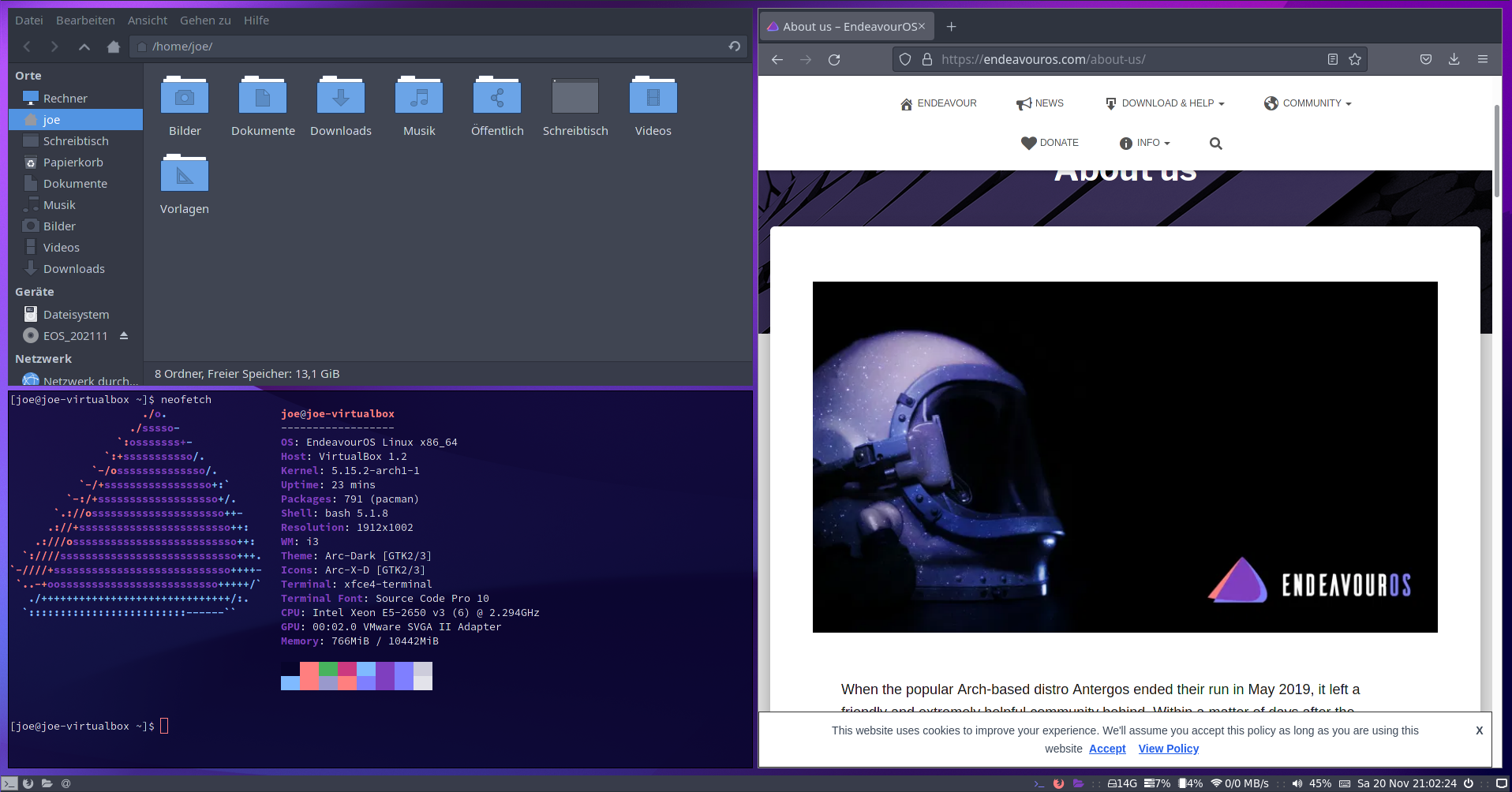- Dotfiles for i3 window manager under EndeavourOS
- Maintained by killajoe (Joe Kamprad)
- You can find some details about enhancements and changes on my blog kamprad.net
Default applications
-
Background Wallpaper - feh
-
File Browser - thunar
-
- Config -
"${HOME}"/.config/gtk-3.0/ "${HOME}"/.config/gtk-4.0/ "${HOME}"/.gtkrc-2.0 "${HOME}"/.local/share/nwg-look/gsettings
- Config -
-
Terminal Emulator - xfce4-terminal
- This is also set inside
"${HOME}"/.profileasexport TERMINAL=xfce4-terminal - If you want to change the default terminal, you need to change it in
"${HOME}"/.profileas well.
- This is also set inside
-
Text Editor - xed
- Config -
xed.dconf - To reset default settings
dconf reset -f /org/x/editor/preferences/editor
- Config -
-
XDG Autostart - dex
- Autostarting apps from
/etc/xdg/autostart/ - Dex is enabled by default in i3 config to autostart applications like on a DE.
- To disable, comment out the line
exec --no-startup-id dex --autostart --environment i3in"${HOME}"/i3/config
- Autostarting apps from
-
Notifications - dunst
- Config -
"${HOME}"/.config/dunst/dunstrc
- Config -
-
App Launcher - rofi
- Config -
"${HOME}"/.config/rofi
- Config -
mod key is set to the Windows/Super key.
Keybindings are different from the i3 defaults to fit into the setup. There are 2 methods that lets you view the default key bindings.
- Method 1 - The keyboard icon on panel opens a little GUI helper.
- Method 2 - By pressing F1 key.
-
Open
arandrand setup the display(s) as per your needs. -
Save the setup from
arandrmenu or button exactly with filenamemonitor. -
In i3 EndeavourOS we have a starter line in the
"${HOME}"/.config/i3/config# start a script to setup displays # put `monitor.sh` into the location specified by this line exec --no-startup-id "${HOME}"/.screenlayout/monitor.sh -
This will handle to set display on each login.
-
Alternatively, you could manually make a script with
xrandr.
Tiling set to default for i3wm and can be changed to
- Stacking Mode - Only the focused window in the container is displayed. You get a list of windows at the top of the container.
- Tabbed Mode - Each new window will open in fullscreen as a tab, you can change between window tabs with mouse or shortcut
- mod+Left focus left (left arrow key)
- mod+Right focus right (right arrow key)
-
Uses
i3blocks. Lets you view workspaces, active i3 blocks, tray icons and launch applications. -
Config -
"${HOME}"/.config/i3/i3blocks.conf -
Pulse Audio
- Use mouse wheel over volume level
- Right click open pulseaudio control
-
Weather
- Get your API key - https://openweathermap.org/appid
- Get your city code - https://openweathermap.org/find?q=
- Search your city and take the city code from the URL bar in your browser (7 numbers at the end of the URL)
- Add the API key and city code to
"$HOME"/.config/i3/scripts/openweather.sh
-
Tray Icons (network manager, update icon, etc.)
-
Logout Button (Cancel, Lock, Logout, Reboot, Shutdown, Suspend etc.)
- Uses
rofi. Lets you perform power actions on your machine. - Config -
"${HOME}"/.config/i3/scripts/powermenu
- Uses
rofi. Lets you launch apps, run commands, switch windows. - Config -
"${HOME}"/.config/rofi
- Uses
powerprofilesctl. Lets you easily switch power modes from the panel bar.
- Rofi Application Menu and Logout Menu
"${HOME}"/.config/rofi/rofidmenu.rasi
"${HOME}"/.config/rofi/powermenu.rasi
- Rofi Color Schemes
"${HOME}"/.config/rofi/arc_dark_transparent_colors.rasi
"${HOME}"/.config/rofi/arc_dark_colors-ori.rasi
Colors are in RGBA, calling transparency in the last column rgba ( 26, 28, 35, 100 % )
- GTK3 Theming and Icons
"${HOME}"/.config/gtk-3.0, "${HOME}"/.Xresources
There is installed where you can browse and set GTK theme, icons and xcursor theme.
Xcursor needs "${HOME}"/.Xresources on cases to have the right size in all cases.
As some applications now went to GTK4 you can add a "${HOME}"/.config/gtk-4.0/settings.ini with only the theme lines:
[Settings]
gtk-theme-name=Arc-Dark
With this gtk4 apps will also follow the theme (will be needed to change manually on theme changes)
For installing it later on, in case if you have installed another DE on initial install from the ISO
-
Clone endeavouros-i3wm-setup dotfiles repo
$ git clone https://github.com/endeavouros-team/endeavouros-i3wm-setup.git $ cd endeavouros-i3wm-setup/etc/skel/ -
Copy the files to user home directories.
$ cp .Xresources "${HOME}"/.Xresources $ cp -R .config/* "${HOME}"/.config/ -
Make all scripts executable inside i3 config
$ chmod -R +x "${HOME}"/.config/i3/scripts -
Apply settings and theming for
xedtext editor$ dbus-launch dconf load / < xed.dconf -
Install using different methods
-
Method 1 - Using EndeavourOS-packages-lists repo
$ wget https://raw.githubusercontent.com/endeavouros-team EndeavourOS-packages-lists/master/i3 $ sudo pacman -S --needed - < i3 -
Method 2 - Using eos-packagelist package from EOS repo
$ eos-packagelist --install 'i3-Window-Manager -
Method 3 - Using the i3_install script from the git for automated config and package installation in user home directory. WARNING - Method 3 will overwrite existing files. Make sure you backup users configs before running it on your own.
$ wget https://raw.githubusercontent.com/endeavouros-team/endeavouros-i3wm-setup/main/i3_install $ ./i3_install
-




